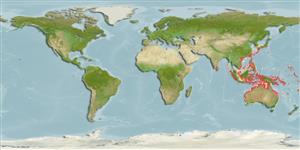>
Eupercaria/misc (Various families in series Eupercaria) >
Labridae (Wrasses) > Corinae
Etymology: Hologymnosus: Greek, holos = full + Greek, gymnos = naked (Ref. 45335).
More on authors: Randall & Yamakawa.
Environment: milieu / climate zone / depth range / distribution range
Sinh thái học
Biển Cùng sống ở rạn san hô; Mức độ sâu 15 - 40 m (Ref. 90102). Tropical
Western Pacific: Japan to Indonesia.
Bộ gần gũi / Khối lượng (Trọng lượng) / Age
Maturity: Lm ? range ? - ? cm
Max length : 32.0 cm TL con đực/không giới tính; (Ref. 9710)
Các tia vây lưng cứng (tổng cộng) : 9; Các vây lưng mềm (tổng cộng) : 12; Tia cứng vây hậu môn: 3; Tia mềm vây hậu môn: 12.
Inhabits seaward reefs, in areas of mixed sand, rubble, and coral (Ref. 9710). Often found in areas with Halimeda algea. May be solitray or form groups. East indian reef fishes of this species are mostly young and rarely larger than 10 cm (Ref. 90102).
Life cycle and mating behavior
Maturities | Sự tái sinh sản | Spawnings | Egg(s) | Fecundities | Ấu trùng
Oviparous, distinct pairing during breeding (Ref. 205).
Randall, J.E. and T. Yamakawa, 1988. A new species of the labrid fish of the genus Hologymnosus from the Western Pacific, with notes on H. longipes. Rev. Fr. Aquariol. 15(1):25-30. (Ref. 5277)
IUCN Red List Status (Ref. 130435)
Threat to humans
Harmless
Human uses
Các công cụ
Special reports
Download XML
Các nguồn internet
Estimates based on models
Preferred temperature (Ref.
123201): 20.6 - 28.8, mean 27.4 °C (based on 174 cells).
Phylogenetic diversity index (Ref.
82804): PD
50 = 0.5625 [Uniqueness, from 0.5 = low to 2.0 = high].
Bayesian length-weight: a=0.00977 (0.00470 - 0.02030), b=3.07 (2.89 - 3.25), in cm total length, based on LWR estimates for this (Sub)family-body shape (Ref.
93245).
Mức dinh dưỡng (Ref.
69278): 3.9 ±0.6 se; based on size and trophs of closest relatives
Thích nghi nhanh (Ref.
120179): Trung bình, thời gian nhân đôi của chủng quần tối thiểu là 1.4 - 4.4 năm (Preliminary K or Fecundity.).
Fishing Vulnerability (Ref.
59153): Low vulnerability (22 of 100).
